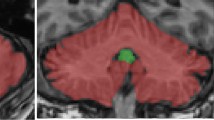Abstract
Abstract
Juvenile neuronal ceroid lipofuscinosis (JNCL, CLN3) is an inherited lysosomal disease. We used longitudinal MRI, for the first time, to evaluate the rate of brain volume alterations in JNCL.
Six patients (mean ages of 12.4 years and 17.3 years) and 12 healthy controls were studied twice with 1.5 T MRI. White matter (WM), gray matter (GM) and CSF volumes were measured from the sets of T1-weighted 3-dimensional MR images using a fully automated image-processing procedure. The brain volume alterations were calculated as percentage change per year. The GM and whole brain volumes decreased and the CSF volume increased significantly more in the patients than in controls (p-values for the null hypothesis of equal means were 0.001, 0.004, and 0.005, respectively). We found no difference in the WM volume change between the populations. In patients, the GM volume decreased 2.4 % (SD 0.5 %, p 0.0001 for the null hypothesis of zero mean change between observations), the whole brain volume decreased 1.1 % (SD 0.5 %, p = 0.003), and the CSF volume increased 2.7 % (SD 1.8 %, p = 0.01) per year. In normal controls, only the mean white matter volume was significantly altered (0.8 % increase, SD 0.7 %, and p = 0.001).
Conclusion
We demonstrated by longitudinal MRI that the annual rate of the gray matter loss in adolescent JNCL patients is as high as 2.4 %.
Similar content being viewed by others
References
Autti T, Raininko R, Vanhanen S-L, Santavuori P (1996) MRI of neuronal ceroid lipofuscinosis I. Cranial MRI of 30 patients with juvenile neuronal ceroid lipofuscinosis. Neuroradiology 38:476–482
Autti T, Raininko R, Santavuori P, Vanhanen SL, Poutanen VP, Haltia M (1997) MRI of neuronal ceroid lipofuscinosis. II. Postmortem MRI and histopathological study of the brain in 16 cases of neuronal ceroid lipofuscinosis of juvenile or late infantile type. Neuroradiology 39:371–377
Claussen M, Heim P, Knispel J, Goebel HH, Kohlschutter A (1992) Incidence of neuronal ceroid-lipofuscinoses in West Germany: variation of a method for studying autosomal recessive disorders. Am J Med Genet 42:536–538
Cooper JD, Russell C, Mitchinson H (2006) Progress towards understanding disease mechanisms in small vertebrate models of neuronal ceroid lipofuscinosis. Biochim Biophys Acta 1762:873–889
Giedd JN, Blumenthal J, Jeffries NO, Castellanos FX, Liu H, Zijdenbos A, Paus T, Evans AC, Rapoport JL (1999) Brain development during childhood and adolescence: a longitunidal MRI study. Nat Neurosci 2:861–863
Giedd JN, Clasen LS, Lenroot R, Greenstein D, Wallace G, Ordaz S, Molloy A, Blumenthal J, Tossel J, Stayer C, Samago-Sprouse C, Shen D, Davatzikos C, Merke D, Chrousos G (2006) Pubertyrelated influenced on brain development. Moll Cell Endocrinol 254–255:144–162
Greene NDE, Lythgoe MF, Thomas DL, Nussbaum RL, Bernard DJ, Mitchison HM (2001) High resolution MRI reveals changes in brains of Cln3 mutant mice. J Paediatr Neurol 5 (Suppl A):103–107
Good CD, Johnsrude IS, Ashburner J, Henson RN, Friston KJ, Frackowiak RS (2001) A voxel-based morphometric study of aging in 465 normal adult human brains. NeuroImage 14:21–36
Haapanen A, Ramadan U, Autti T, Joensuu R, Tyynelä J (2007) In vivo MRI reveals dynamics of pathological changes in the brains of cathepsin Ddeficient mice and correlates changes in manganase-enhanced MRI with microglial activation. Magn Reson Imaging 25:1024–1031
Haltia M (2006)The neuronal ceroidlipofuscinoses: from past to present. Biochim Biophys Acta 1762(10):850–856
Järvelä I, Autti T, Santavuori P, Raininko R, Åberg L, Peltonen L (1997) Clinical and MRI findings in Batten disease – analysis of the major mutation. Ann Neurol 42:799–802
Lenroot R, Gogtay N, Greenstein D, Wells E, Wallace G, Clasen L, Blumenthal J, Lerch J, Zijdenbos A, Evans A, Thompson P, Giedd J (2007) Sexual dimorphism of brain developmental trajectories during childhood and adolescence. Neuroimage 36:1065–1073
Mole SE (2004) The genetic spectrum of human neuronal ceroid-lipofuscinoses. Brain Pathol 14:70–76
Paus T, Collins DL, Evans AC, Leonard G, Pike B, Zijdentos A (1999) Maturation of the white matter in the human brain: a review of magnetic resonance studies. Brain Res Bull 54:255–266
Phillips SN, Benedict JW, Weimer JM, Pearce DA . (2005) CLN3, the protein associated with Batten disease: structure, function and localization. J Neurosci Res 79:573–583
Purves D (1980) A trophic theory of neural connections. In: Body and Brain Cambridge,MA: Harvard University Press
Santavuori P, Lauronen L, Kirveskari E, Åberg L, Sainio K, Autti T (2000) Neuronal ceroid lipofuscinoses in childhood. Neurol Sci 21:S35–S41
Santavuori P, Vanhanen S-L, Autti T (2001) Clinical and neuroradiological diagnostic aspects of neuronal ceroid lipofuscinoses disorders. Eur J Paediatr Neurol 5 (Suppl A):157–161
Sowell ER, Thompson PM, Holmes CJ, Batth R, Jernigan TL, Toga AW (1999) Localized age-related changes in brain structure between childhood and adolescence using statistical parametric mapping. NeuroImage 9:587–597
Thompson. P, Hayashi K, Zubicaray G, Janke A, Rose S, Semple J, Herman D, Hong M, Dittmer S, Doddrell D, Toga A (2003) Dynamics of gray matter loss in Alzheimer`s disease. J Neurosci 23:994–1005
Wilke M, Krägeloh-Mann I, Holland S (2007) Global and local development of gray and white matter volume in normal children and adolescents. Exp Brain Res 178:296–307
Åberg L, Liewendahl K, Nikkinen P, Autti T, Rinne JO, Santavuori P (2000) Decreased striatal dopamine transporter density in JNCL patients with parkinsonian symptoms. Neurology 54:1069–1074
Author information
Authors and Affiliations
Corresponding author
Rights and permissions
About this article
Cite this article
Autti, T.H., Hämäläinen, J., Mannerkoski, M. et al. JNCL patients show marked brain volume alterations on longitudinal MRI in adolescence. J Neurol 255, 1226–1230 (2008). https://doi.org/10.1007/s00415-008-0891-x
Received:
Revised:
Accepted:
Published:
Issue Date:
DOI: https://doi.org/10.1007/s00415-008-0891-x




